Operation Quiet - Collusion with the Russians (and Chinese) on Sound Deadening
When it comes to the subject of Sound Deadening, it is not something most Wrangler owners care about. “A Jeep is supposed to be noisy” or “Why bother, a Wrangler is like a brick driving down the road”, many will say. And I understand, many folks bought their TJ to drive off-road as it’s primary duty. If you like to wash out your tub with a garden hose, then this modification is not for you.
For me, I fall into another camp, and this is why Operation Quiet was launched. Keeping with the OEM+\Restomod build theme, my 2005 TJ is a 99% streeted vehicle with casual off-roading duty. My goals are preservation, reliability, and adding touches of modern convenience. One issue with using a TJ as a daily driver, as Jeepers warned, these SOB’s are noisy by nature. When I commute in the TJ, it is usually 60-70 minutes, but it can be more if I drive somewhere for lunch or run an errand after work. 95% of the time, I am either listening to music or podcasts, having a conversation with a person, or taking a hands free call. It was definitely worth some time for me to investigate how much I could improve on the noise problem. Fortunately, since Jeep did nothing at the factory to keep the TJ cabin quiet, it wasn’t hard to make improvements.
Just to note...My TJ has the factory installed hardtop and full doors. More importantly, they are in great shape and seal perfectly. I don’t have any known leaks that can be heard inside the cabin. For tires, I have newer A/T BFG KO2’s with about 1,500 miles. They are relatively quiet as compared to other tires in this class. So, at least I had these things going for me. Otherwise, fixing leaks and getting a top installed that was better for noise would have needed to be the first order of business.
Sound deadening, sound damping, sound absorbing, sound proofing, vibration absorbing, echos, resonance frequencies…I was far from an expert coming into this project. Many think sound deadening in autos is only for audiophiles, but it is also for those who want less road and engine noise. While it can be a complex subject if you really want to get into the details, the good news is there are easy solutions and some great affordable products available (especially in 2018).
First, a little background and some technical info. Let’s start with some applicable vocabulary:
Sound :
The problem: we have a bunch of vibrations assaulting our TJ. These are classified into two basic categories:
The confluence of vibrations from outside and inside the tub cause an orchestra of unwanted sound (i.e noise) in the cabin. This is where sound deadening material comes in. It has the ability to dampen parts of the orchestra before it has a chance to get started.
The end result of a sound deadening job cannot be fully measured and demonstrated by a simple decibel meter. At first, I was planning to diligently measure the before and after results. After playing around with sound measuring apps on my Pixel XL (1st gen), I wanted to know how to best conduct the measurements and if they could be compared to other vehicles, even if just TJ’s. After some research, I decided not to waste my time on trying to take measurements. While you can demonstrate a decibel level reduction by measuring with these apps in different spots in your cabin, there are several caveats:
More on the subject of mobile phone app sound meters and sound filters:
https://www.cirrusresearch.co.uk/blog/2017/09/sound-level-meter-apps-accuracy/
https://www.engineeringtoolbox.com/decibel-d_59.html
To really be able to fully measure the results of a sound deadening project, I believe you would need a standardized test with more sophisticated metering devices and software, likely using a microphone array and vibration meters to measure input throughout different locations in the vehicle under different conditions (idle, acceleration from a stop, cruising at 40 MPH, highway 70 MPH, gravel road, heavy traffic etc.). The results would also need to be able to be broken down into 16 or so different human detectable frequencies and lower level vibrations to demonstrate which parts of the spectrum had been reduced or eliminated.
That all said, the best way to understand the difference is to experience it! Fortunately, when done properly with quality materials, the end results typically go far beyond the placebo effect.
Stage 1 - Tub sound deadening
I decided on a highly rated product from the Russian Federation and a company called Noico (https://noico.info). Hopefully US government officials won’t be coming to my door asking questions about why this fine Russian product was shipped to my door! I just want my TJ to be quiet, I will tell them!
The specific product I used is called “Noico 80 mil Sound deadening mat” and you can buy it on Amazon:
https://www.amazon.com/dp/B00URUIKAK/?tag=wranglerorg-20
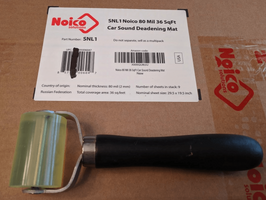
I am very impressed with Noico 80, it’s adhesive quality, and ability to be molded, rolled etc. It has an indicator (3D diamonds) that are flattened when it is rolled down properly. It is very easy to work with. I would advise to wear gloves and take caution when cutting and working with it. The metal top layer is sharp and can cut you up. I didn’t notice any rubber smell that I can detect in the cabin after the job was complete. There was only a slight rubber odor during the install, but I haven’t smelled it since.
Some reviews and links I found useful:
Stage 1 Cost: $96.98
Noico 80 mil:
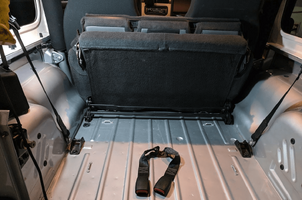
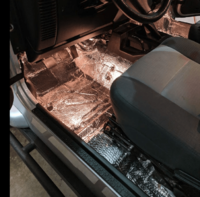
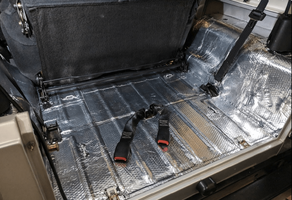
All done!
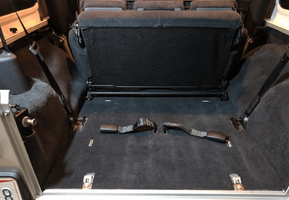
Stage 2 - Hoodliner
Since the factory didn’t install a hoodliner on most TJ’s (and the Mopar part is expense and hard to find), I wanted to install something to cut down on engine and fan noise that was bouncing around the engine bay and getting into the cabin. I found this step to be more effective (synergistic) after stage 1 was completed, thus I call it stage 2. Regardless of what some say, the Noico 80 product used in Stage 1 isn’t rated for under hood temps per the manufacturer. It is rated nicely for inside the tub with a temperature range of -49F to +212F.
Instead, I sourced the following 394 mil Car Auto Firewall Heat Sound Deadener Insulation Mat from Amazon:
https://www.amazon.com/dp/B072WKT78M/?tag=wranglerorg-20
The seller on Amazon is uxcell and the product also is listed as uxcell. But, when it arrives, the product is actually labeled as XCELL (shown on a glossy paper including instructions). The product is made in China. The quality was decent and it was easy to work with. We’ll see how it holds up over time. They don’t provide temperature ratings, but the outer cloth material is made of fiberglass. This, and the fact that others were using it for this purpose, made me feel more comfortable giving it a try.
Stage 2 Cost: $48.99 (I still have quite a bit of the 21.5 sq ft left over)
Stage 2 Notes:
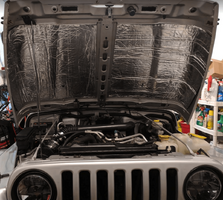
Conclusion
The results have exceeded my expectations. It is truly an amazing transformation to how much more comfortable the cabin is. You not only hear the difference, you can also “feel” the difference. For a total of $145.97, I consider it money well spent for this project. It was an easy project that was just a little time consuming.
The biggest test was my wife. She has a hearing condition in one ear and excessive noise can be tiring for her. She has complained about the noise in the TJ since I bought it in the Spring. She thinks it rides great, but the noise is the main thing about the TJ she doesn’t like (unless we purposely have the top off). Most of the time, when I modify cars, she either can’t tell the difference or doesn’t care, or both! For this test, we took a long drive across town on varied roads. She could tell the difference in the driveway when she climbed in just sitting at idle with the radio on…we hadn’t even moved yet! During and after the drive, she couldn’t stop raving about how big of an improvement it was. Needless to say, I was pretty psyched up about it.
Pros:
I am not sure if I want or need to go further. However, if there is a stage 3 and beyond, here is what I think they would be. Please let me know if anyone has experience or suggestions on this topic.
Stage 3 - TBD - Sound deadening inside the full doors and rear gate
I have some XCELL left I could use for the doors, but Noico would be better. For the rear gate I would want a better looking acoustic panel of some sort.
Stage 4 - TBD - Hardtop Headliner
Looking for some cheaper options for some acoustic panels. Might build my own kit, something like the following if possible. But, I want it to look good and I will need it not to drop on my head!
https://www.extremeterrain.com/boommat-blk-headliner-tj-50143.html
https://www.amazon.com/dp/B008SAX5LA/?tag=wranglerorg-20
Stage 4 + TBD - Other ideas?
When it comes to the subject of Sound Deadening, it is not something most Wrangler owners care about. “A Jeep is supposed to be noisy” or “Why bother, a Wrangler is like a brick driving down the road”, many will say. And I understand, many folks bought their TJ to drive off-road as it’s primary duty. If you like to wash out your tub with a garden hose, then this modification is not for you.
For me, I fall into another camp, and this is why Operation Quiet was launched. Keeping with the OEM+\Restomod build theme, my 2005 TJ is a 99% streeted vehicle with casual off-roading duty. My goals are preservation, reliability, and adding touches of modern convenience. One issue with using a TJ as a daily driver, as Jeepers warned, these SOB’s are noisy by nature. When I commute in the TJ, it is usually 60-70 minutes, but it can be more if I drive somewhere for lunch or run an errand after work. 95% of the time, I am either listening to music or podcasts, having a conversation with a person, or taking a hands free call. It was definitely worth some time for me to investigate how much I could improve on the noise problem. Fortunately, since Jeep did nothing at the factory to keep the TJ cabin quiet, it wasn’t hard to make improvements.
Just to note...My TJ has the factory installed hardtop and full doors. More importantly, they are in great shape and seal perfectly. I don’t have any known leaks that can be heard inside the cabin. For tires, I have newer A/T BFG KO2’s with about 1,500 miles. They are relatively quiet as compared to other tires in this class. So, at least I had these things going for me. Otherwise, fixing leaks and getting a top installed that was better for noise would have needed to be the first order of business.
Sound deadening, sound damping, sound absorbing, sound proofing, vibration absorbing, echos, resonance frequencies…I was far from an expert coming into this project. Many think sound deadening in autos is only for audiophiles, but it is also for those who want less road and engine noise. While it can be a complex subject if you really want to get into the details, the good news is there are easy solutions and some great affordable products available (especially in 2018).
First, a little background and some technical info. Let’s start with some applicable vocabulary:
Sound :
- vibrations that travel through the air or another medium and can be heard when they reach a person's or animal's ear.
- a compression wave created by a vibrating object (also know as Longitudinal waves).
- A sound wave is the pattern of disturbance caused by the movement of energy traveling through a medium as it propagates away from the source of the sound. The source is some object that causes a vibration.
- In physics, resonance is a phenomenon in which a vibrating system or external force drives another system to oscillate with greater amplitude at specific frequencies. Frequencies at which the response amplitude is a relative maximum are known as the system's resonant frequencies or resonance frequencies.
- a reflection of sound that arrives at the listener with a delay after the direct sound.
- dissipates vibrational energy before it can build up and radiate as sound.
- a process or material that reduces the resonance or volume of sound modifier.
- reducing the resonance or volume of sound, sound deadening insulation/material/pads.
The problem: we have a bunch of vibrations assaulting our TJ. These are classified into two basic categories:
- Outside the cabin - vibrations from under the Jeep (suspension, road noise, driveline etc.) and from the engine bay (engine and fan) are the top two culprits. These vibrations are able to get through to the tub bare metal (medium) and into the cabin as sound you can hear and other vibrations you can feel. Vibrations propagate through the tub into other mediums attached to the tub, causing them also to vibrate and potentially rattle (center console, dash, hardtop etc.).
- Inside the cabin - on the flip side, when you play music, use your fan/heat/AC, have conversation, kids playing games (or all 4 at the same time!), these sound waves originating inside the cabin cause secondary cascading vibrations and echos.
The confluence of vibrations from outside and inside the tub cause an orchestra of unwanted sound (i.e noise) in the cabin. This is where sound deadening material comes in. It has the ability to dampen parts of the orchestra before it has a chance to get started.
The end result of a sound deadening job cannot be fully measured and demonstrated by a simple decibel meter. At first, I was planning to diligently measure the before and after results. After playing around with sound measuring apps on my Pixel XL (1st gen), I wanted to know how to best conduct the measurements and if they could be compared to other vehicles, even if just TJ’s. After some research, I decided not to waste my time on trying to take measurements. While you can demonstrate a decibel level reduction by measuring with these apps in different spots in your cabin, there are several caveats:
- Some phones and apps can be reliable for general types of sound measurement (occupational hazards etc.), but this depends on the phone brand, model, OS, and app used. iPhones are generally better for this because the app developer is always targeting the same hardware as the end-users. For Android, it is more of a crap shoot since the hardware and software is so varied between devices (consult the developer for recommendations).
- The placement of the phone’s microphone, it’s quality, and differences in the ambient environment can vary between tests. This makes comparing your own results tricky and comparing your results with others almost impossible without some sort of standardized protocol and environment.
- The sound meter apps are measuring all frequencies at once (“pink noise”) and most of the time we don’t know how the raw input is filtered or weighted by the software before it shows the output (see the app developer documentation for any provided details). Most apps use SPL per the article from Cirrus Research below.
More on the subject of mobile phone app sound meters and sound filters:
https://www.cirrusresearch.co.uk/blog/2017/09/sound-level-meter-apps-accuracy/
https://www.engineeringtoolbox.com/decibel-d_59.html
To really be able to fully measure the results of a sound deadening project, I believe you would need a standardized test with more sophisticated metering devices and software, likely using a microphone array and vibration meters to measure input throughout different locations in the vehicle under different conditions (idle, acceleration from a stop, cruising at 40 MPH, highway 70 MPH, gravel road, heavy traffic etc.). The results would also need to be able to be broken down into 16 or so different human detectable frequencies and lower level vibrations to demonstrate which parts of the spectrum had been reduced or eliminated.
That all said, the best way to understand the difference is to experience it! Fortunately, when done properly with quality materials, the end results typically go far beyond the placebo effect.
Stage 1 - Tub sound deadening
I decided on a highly rated product from the Russian Federation and a company called Noico (https://noico.info). Hopefully US government officials won’t be coming to my door asking questions about why this fine Russian product was shipped to my door! I just want my TJ to be quiet, I will tell them!
The specific product I used is called “Noico 80 mil Sound deadening mat” and you can buy it on Amazon:
https://www.amazon.com/dp/B00URUIKAK/?tag=wranglerorg-20

I am very impressed with Noico 80, it’s adhesive quality, and ability to be molded, rolled etc. It has an indicator (3D diamonds) that are flattened when it is rolled down properly. It is very easy to work with. I would advise to wear gloves and take caution when cutting and working with it. The metal top layer is sharp and can cut you up. I didn’t notice any rubber smell that I can detect in the cabin after the job was complete. There was only a slight rubber odor during the install, but I haven’t smelled it since.
Some reviews and links I found useful:
- https://soundproofliving.com/noico-dynamat-review/
- https://www.crutchfield.com/S-jBUPu7bnCXq/learn/learningcenter/car/vibration_installation.html
- https://aquietrefuge.com/noico-sound-deadener-review/
- https://soundproofcentral.com/recommended-products/best-sound-deadeners/
Stage 1 Cost: $96.98
Noico 80 mil:
- $63.99 for 36 sq ft - coverage: inside firewall as far up as I could possibly go, front foot wells, center tunnel, under seats, lower tub sides (but not full doors), rear foot wells, and just barely over the hump into the cargo area.
- $32.99 for 18 sq ft - coverage: cargo area floor, rear wheel wheels and rear sides (but not rear gate).
- I won’t go into detail since there is volumes of info on this subject. Make sure you follow the instructions provided (clean the tub bare metal very well, be savvy about measuring and cutting, roll out material to install properly, follow the installation temp suggestions etc.).
- Watch the video on the Noico website. There are also many Dynamat and Noico reviews and videos around the Internet that will apply in general here.
- Tools: kitchen shears, utility knife, exacto knife, whatever works for you. Just wear gloves as I mentioned since it can be sharp!
- Don’t skimp and use cheaper unproven materials if you want the best results. There is also a Noico 50 that is a little cheaper, but again I say don’t skimp. The 80 mil (80 thousandths of an inch thickness) doesn’t cost much more than the 50 mil. It is the 80 mil product that is highly touted.



All done!

Stage 2 - Hoodliner
Since the factory didn’t install a hoodliner on most TJ’s (and the Mopar part is expense and hard to find), I wanted to install something to cut down on engine and fan noise that was bouncing around the engine bay and getting into the cabin. I found this step to be more effective (synergistic) after stage 1 was completed, thus I call it stage 2. Regardless of what some say, the Noico 80 product used in Stage 1 isn’t rated for under hood temps per the manufacturer. It is rated nicely for inside the tub with a temperature range of -49F to +212F.
Instead, I sourced the following 394 mil Car Auto Firewall Heat Sound Deadener Insulation Mat from Amazon:
https://www.amazon.com/dp/B072WKT78M/?tag=wranglerorg-20
The seller on Amazon is uxcell and the product also is listed as uxcell. But, when it arrives, the product is actually labeled as XCELL (shown on a glossy paper including instructions). The product is made in China. The quality was decent and it was easy to work with. We’ll see how it holds up over time. They don’t provide temperature ratings, but the outer cloth material is made of fiberglass. This, and the fact that others were using it for this purpose, made me feel more comfortable giving it a try.
Stage 2 Cost: $48.99 (I still have quite a bit of the 21.5 sq ft left over)
Stage 2 Notes:
- Cut out two 28” x 28” inch pieces from the large sheet.
- Clean the inside of the hood metal very well. I used rubbing alcohol as the last step since it evaporates quickly and does a good job lifting oily residue.
- Don’t install over the channel/holes in the center seam of the hood. This channel appears to carry heated air to the window solvent sprayer to keep it thawed out, and may have other purposes.
- Carefully position and trim. Tuck all ends into the edges of the hood around the perimeter. You’ll see what I mean once you see the pics and look at your hood. It takes time, but wedge it under the metal edge for a clean look.
- Spread and roll the material flat over the contours of the hood so you don’t leave any air gaps. This will make sure the product works as well as it can and ensures that the adhesive is set as best as is possible.
- Consider using metal clips in addition to the adhesive. I’m currently investigating clips for the long haul as I keep an eye on the adhesive over time.

Conclusion
The results have exceeded my expectations. It is truly an amazing transformation to how much more comfortable the cabin is. You not only hear the difference, you can also “feel” the difference. For a total of $145.97, I consider it money well spent for this project. It was an easy project that was just a little time consuming.
The biggest test was my wife. She has a hearing condition in one ear and excessive noise can be tiring for her. She has complained about the noise in the TJ since I bought it in the Spring. She thinks it rides great, but the noise is the main thing about the TJ she doesn’t like (unless we purposely have the top off). Most of the time, when I modify cars, she either can’t tell the difference or doesn’t care, or both! For this test, we took a long drive across town on varied roads. She could tell the difference in the driveway when she climbed in just sitting at idle with the radio on…we hadn’t even moved yet! During and after the drive, she couldn’t stop raving about how big of an improvement it was. Needless to say, I was pretty psyched up about it.
Pros:
- Less road noise, engine noise, and mechanical fan noise (make sure you do the inside firewall well and as high as you can go!)
- Less exhaust noise (I have the Banks Monster exhaust that is only slightly louder than stock on a TJ with the 3 cats. It is now even quieter as heard from the cabin).
- Less vibration and odd noises throughout the entire vehicle in general.
- Better sounding audio - I don’t have to turn up the volume nearly as high to hear the stereo clearly (level 10-12 now vs. level 18-20 before).
- More tolerable on longer drives and human conversation.
- Added 40 lbs of weight.
- Takes a few hours to install.
- Can’t hose out the tub (drain plugs are still free and operational. I cleaned and treated the plug holes with Fluid Film).
- Cost? It isn’t really expensive to do yourself, but it would be more costly if installed by a professional.
- Hoodliner causes TJ to overheat or causes too much heat in the engine bay? I doubt it since there was a factory hoodliner on some TJ’s. The coolant thermostat may kick in more often if there is more heat to handle, but the engine bay is far from sealed. So far, I haven’t noticed any issues. The lining is cool enough to touch when opening the hood at operating temperature.
I am not sure if I want or need to go further. However, if there is a stage 3 and beyond, here is what I think they would be. Please let me know if anyone has experience or suggestions on this topic.
Stage 3 - TBD - Sound deadening inside the full doors and rear gate
I have some XCELL left I could use for the doors, but Noico would be better. For the rear gate I would want a better looking acoustic panel of some sort.
Stage 4 - TBD - Hardtop Headliner
Looking for some cheaper options for some acoustic panels. Might build my own kit, something like the following if possible. But, I want it to look good and I will need it not to drop on my head!
https://www.extremeterrain.com/boommat-blk-headliner-tj-50143.html
https://www.amazon.com/dp/B008SAX5LA/?tag=wranglerorg-20
Stage 4 + TBD - Other ideas?
- Engine bay/outside firewall (material at strategic spots to stop vibrations)
- Muffler/exhaust shield on bottom of tub in select locations?
- Hood wind/bug deflector (I won’t be doing this since I don’t care for the look on any car)
- Remove crappy T-Case linkage and replace with Savvy cable if yours is making noise (mine is fine for now after I fixed and lubed it up).

